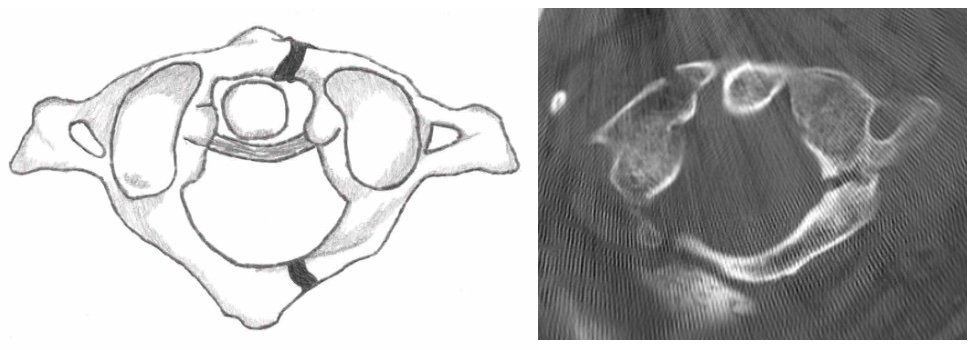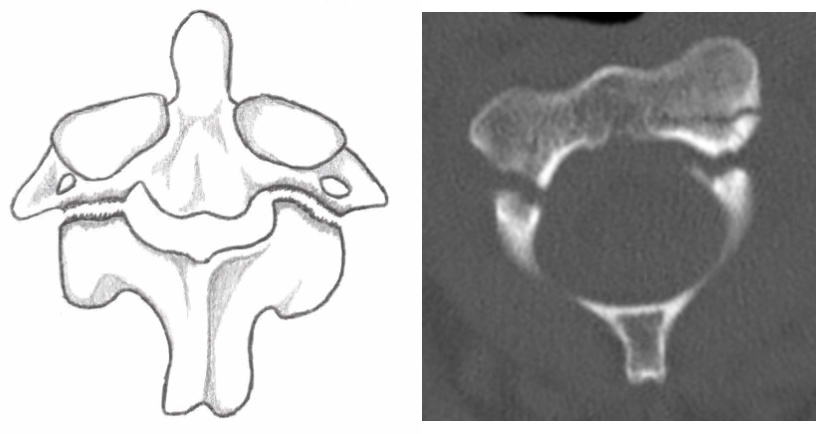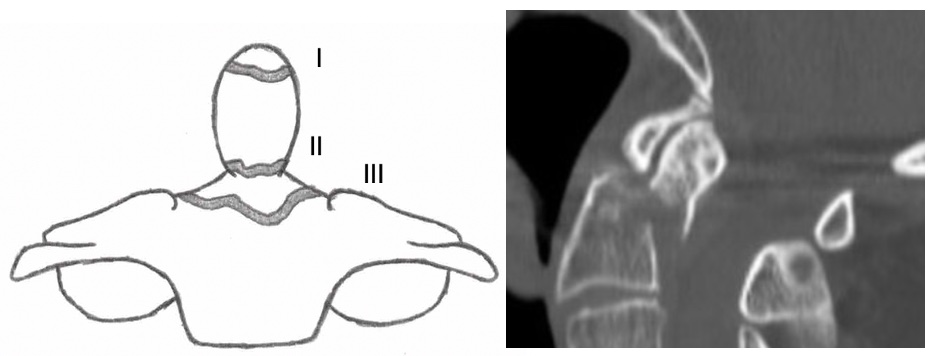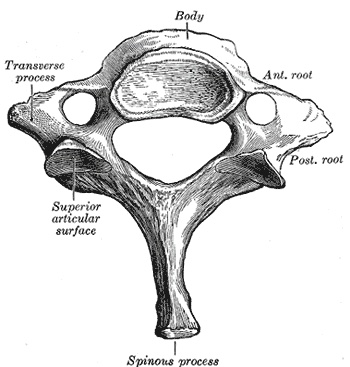Cervical Spine Fracture
Cervical Spine Fracture
David Ray Velez, MD
Table of Contents
General Considerations
High Morbidity and Mortality Injury, Particularly in the Elderly (Mortality > 20%)
The Most Common Cervical Spine Fracture is a C2 Odontoid Fracture
Most Common Cause: Falls
Respiratory Failure
- Cervical Spine Fractures Have High Risk for Hypoxia and Respiratory Failure
- Due to Damage to the Nerves Controlling the Muscles of Respiration – Particularly the Phrenic Nerve Controlling the Diaphragm (Origin: C3-C5)
- Require Frequent Suctioning and Pulmonary Toilet
Blunt Cerebrovascular Injury (BCVI)
- Overall Risk: 30-70%
- Specific Risk Factors:
- High Cervical Spine (C1-C3) Fractures
- Multi-Level Fractures
- Fractures Associated with Dislocation/Subluxation
- Transverse Foramen Fractures
- *See Blunt Cerebrovascular Injury (BCVI)
Other Associated Injuries
- Rib Fractures
- Sternal Fracture
- Facial Fracture
- Base of the Skull Fracture
C1 (Atlas) Fracture
C1 Burst (“Jefferson”) Fracture: Fracture of Both the Anterior and Posterior Arches
Jefferson (Landell and Van Peteghem) Classification
- Type I: Isolated Fracture of Either the Anterior or Posterior Arch
- Type II: Fractures of Both the Anterior and Posterior Arches (Burst Fracture)
- Type III: Lateral Mass Fracture
Gehweiler Classification
- Type I: Isolated Fracture of the Anterior Arch
- Type II: Isolated Fracture of the Posterior Arch
- Type III: Fractures of Both the Anterior and Posterior Arches (Burst Fracture)
- Type IV: Lateral Mass Fracture
- Type V: Fracture of the Transverse Process
Atlanto-Occipital Dislocation (AOD): Severe Disruption of the Ligaments Between the Base of the Skull and Atlas
- Also Known as: “Internal Decapitation”
- High Mortality (70% Suffer Immediate Death)
Stability
- Determined by Disruption of the Transverse Ligament
- Jefferson Type I (Gehweiler Type I or II) are Usually Stable
- Jefferson Type II or III (Gehweiler Type III or IV) are Usually Stable
Treatment
- Stable: Rigid Collar for 6-12 Weeks
- Unstable: Debated (Rigid Collar or Surgical Stabilization)

C1 Burst “Jefferson” Fracture
C2 (Axis) Fracture
Traumatic Spondylolisthesis of the Axis (“Hangman’s Fracture”)
- Definition: Fracture Through the Bilateral Pars Interarticularis of C2
- Usually From Hyperextension Injuries
- Unstable but Cord Damage is Often Minimal
- Anterior-Posterior Diameter is Highest at C2 and Bilateral Fracture Allows Decompression
- Treatment: Rigid Collar, Halo Immobilization, or Surgical Stabilization Based Upon Displacement and Stability

C2 Hangman’s Fracture
C2 Odontoid/Dens Fracture
- Anderson and D’Alonzo Classification:
- Type I: Above the Base – Generally Stable
- Type II: At the Base
- Type III: Into the Vertebral Body – Better Healing Rates Than Type II
- Treatment:
- Type I: Rigid Collar for 6-12 Weeks
- Type II: Surgical Stabilization
- Consider Halo Immobilization if Young and No Risk for Nonunion
- Consider Rigid Collar Alone for Elderly Patients that are Not Surgical Candidates
- Type III: Debated (Rigid Collar or Surgical Stabilization)

C2 Odontoid/Dens Fracture
C3-C7 (Sub-Axial) Fracture
Anatomical Columns
- Anterior Column: Anterior Half of the Vertebral Body and Anterior Longitudinal Ligament
- Middle Column: Posterior Half of the Vertebral Body and Posterior Longitudinal Ligament
- Posterior Column: Facets, Lamina, Spinous Process, and Interspinous Ligament
Subaxial Vertebral Body Fracture
- Compression (Wedge) Fracture
- Fracture of the Anterior Vertebral Body
- Caused by Hyperflexion
- Burst Fracture
- Fracture of the Anterior and Middle Columns
- May Have Retropulsion into the Spinal Canal
- Caused by Compressive Forces
- Flexion Teardrop Fracture
- Anterior-Inferior Corner Fracture from Vertebral Body Collision
- Caused by Hyperflexion
- Extension Teardrop Fracture
- Anterior-Inferior Corner Fracture from Anterior Longitudinal Ligament Avulsion
- Caused by Abrupt Extension
- Treatment: Rigid Collar or Surgical Stabilization Based Upon Fracture Pattern, Stability, and Neurologic Deficits
- Early Decompression (< 24 Hours) Has Shown Improved Neurologic Outcomes Compared to Delayed Decompression (> 24 Hours)
Cervical Spinous Process (“Clay-Shoveler’s”) Fracture
- Usually Occurs in Isolation
- Most Common Location: C7
- Can Affect C6-T3
- Excellent Clinical Outcomes with High Union Rates
- Treatment: Conservative (NSAIDs and Collar for Comfort)

Subaxial Cervical Vertebrae
